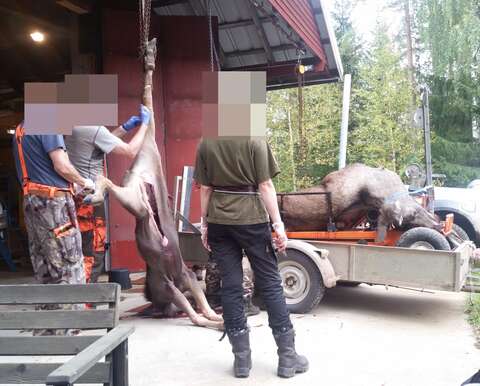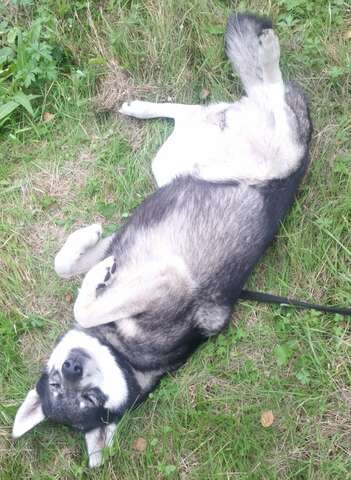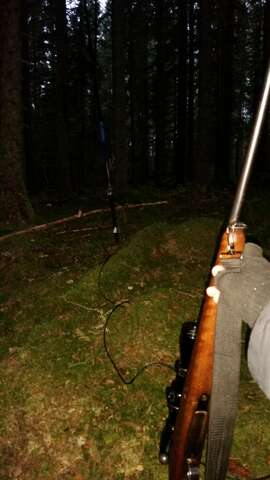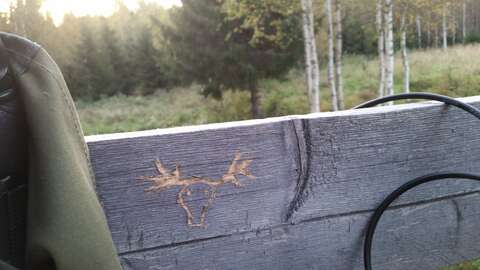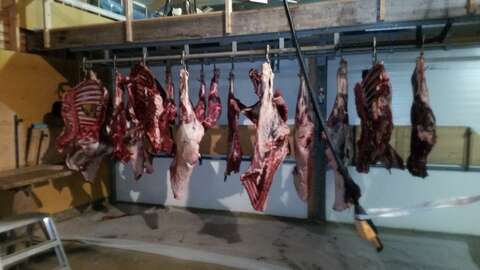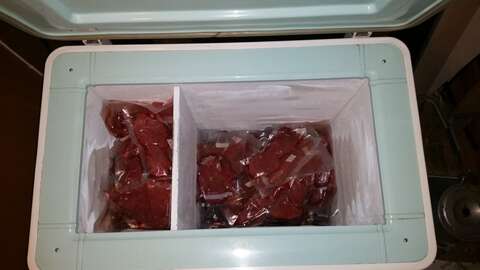This year I participated in my second moose hunt. This post documents my experiences with it, and some statistics. Like last time, dead animals ahead.
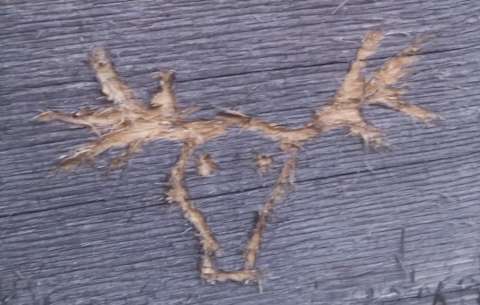
Preparations
Antennas
Last year I was donated several marine VHF antennas from my younger brother, which just so happen to also work great for the section of the VHF band used for hunting (155.400 - 155.525 MHz). This year I put up another antenna in another tower, bringing the total number of antennas to two. I would have put up more, but I didn't have sufficient coaxial cables with UHF connectors at hand. I've since made a bunch of coax cables with a PL-259 connector in one end and an SMA male connector in the other. All cables, including those in the field, also have an SMA-to-BNC converter attached, held onto the coax with some steel wire.
Due to the team's lottery system for shooters' spots, I didn't get to use the tower on my property this year. This had the benefit of seeing how well my antenna setup would work with someone who isn't a licensed radio amateur. In this case the answer was "not at all", since their radio's connector was, as far as I've been able to glean, neither SMA nor BNC.
OpenStreetMap
New for this year is that I put all the shooters' spots into OpenStreetMap as amenity=hunting_stand. This was quite a bit of work since there's over 100 spots in our team. The tagging isn't perfect since a lot of spots have no stands on them, just a sign and some firewood. They still qualify for tagging however, since they are marked with a sign.
The way I went about putting the spots into OSM was by loading our team's maps into JOSM as image layers, rotating and scaling them to fit as well as possible, and then transferring the various spots by placing nodes over them. The maps we have are drawn with marker pens on overhead film, like the example below:
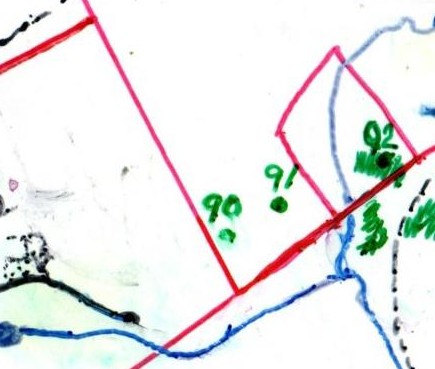
This means there's a lot of inaccuracy in the spots, which will become relevant later.
The spots have also been put into a proprietary phone app called Tracker, which I can't run on my phone since I use LineageOS. I also don't want to run it on my phone. Here I'm also making a tiny stand in favor of OSM, such that we perhaps over time can move away from marker ink on overhead film and from locking away our data in a proprietary app that can alter the deal at any time.
Scouting my spots
Two of my spots this year were stands that I was already familiar with. But one spot, spot 90, was quite far away from any roads, and the closest road is a very overgrown one. This spot is visible in the map above. The distance from the roundabout in the lower left and spot 90 is 323 meters. Walking distance is 425 meters.
Because I didn't know the terrain, I decided to check the spot out a few days before the hunt, just to be sure I could find it. This was a good call, because it turned out to be tricky to find! The area is quite wet, showing that my watertight hunting boots were a good investment. The area is also very mossy, which will become relevant later. Having located the spot, I made a note of its exact position and updated the OSM node for it later on.
By contrast I did not choose to check out another spot, spot 75, since it was quite close to a road. This cause some delay when its time came, because I couldn't find it! Turns out the markings on the maps we'd been given are only approximate, and its actual position was some 70 meters off.
Shooting test
Many moose teams require that its members take a shooting test every year, including my team. The test for moose involves a moving target. A total of four shots are to be taken, all of which must hit within the lung area. First a stationary shot, then a three second delay, then a shot on the target moving sideways. Then the target stops and the procedure repeats in the opposite direction. The distance is 80 meters. If any shot misses then the test must be retaken.
During my exam last year I nailed three such series of four in a row. This year I missed one moving shot on two series before finally nailing the third series. Unfortunately I had forgotten to buy FMJ training ammo so I had to use hunting ammunition during the test. A costly mistake, as we shall soon see.
Weather
The weather forecast for the hunt was no rain and temperatures ranging from 10°C in the morning to 25°C in the middle of the day. This is unusually warm for September, which will become relevant later.
The hunt
The hunt this year for our team started on Thursday September 5:th at 05:00. This is one hour earlier than last year, meaning I had to get up at 04:00. Hooray!
Thursday
First day. Got up at 4:00-ish, brewed coffee, ate a sandwich, put the coffee in a thermos, the thermos in my pack and then the pack and my rifle in my car, after which I drove to my spot. This spot was a stand by a road, but not one of the stands that I had outfitted with an antenna. I therefore got the opportunity to try a portable antenna that I had built out of a fishing pole, some coax and a bit of copper wire. This worked well enough that I could hear everyone in the team. I also rigged the audio such that I could hear my radio and my phone at the same time, for being able to listen to podcasts to pass the time. Having some snacks also helps, especially pistachios, since you have to peel them.
After about an hour I heard barking, and was informed over the radio that I had a cow and calf heading in my direction. The barking was to my right, so I got myself ready in that direction. After about an hour of not seeing anything the barking shifted to my left and I with it. After about another hour of constant barking and not seeing anything it seemed that no moose were coming. And indeed no moose came. But the rest of the team did have some luck. Before lunch we had one calf felled.
I could not help much with the slaughtering due to having cut my finger a few days before, and open wounds are a no-no when handling food, even with latex gloves. I know this from my time working the kitchen at Kårhuset Origo.
Here is where the weather gets relevant. Because of the high noon temperature we couldn't let the dogs work for fear of giving them heat stroke. We therefore let all the dogs do their work before lunch. Due to the lack of dogs we decided to substitute them with some humans after lunch. We spent the afternoon doing "driven" or "push" hunt (drevjakt), which resulted in another calf and one heifer felled. Despite having some success, we decided not to try this style of hunt on subsequent days due to the heat also getting to our humans. Therefore the remaining days were just half days.
Total animals felled so far: 3
Friday
My friday spot was not in a stand but just a spot on the ground. This again gave me the opportunity to try out my portable antenna, which again seems to have worked well. Because the spot was on the ground, I brought a foldable chair with me. My backpack has a chair built in, but it has no back support, so I decided to bring this luxurious folding chair. Truly decadent.
Despite the back support I still had to get up and stretch a couple of times. During one of these stretches I noticed something moving in the corner of my eye. It was a moose! A heifer probably. As quickly as I could I put my hearing protection back on, grabbed my rifle and unsafed it. But by that point she was already gone. After having calmed down, and after waiting a few minutes just in case she came back, I radioed my neighbors to let them know there was a heifer in the area and the direction she went in. Though disappointing, this was also exciting! Never let your guard down, never put your gun away, not even for a second!
Despite this minor disappointment we had four animals felled before lunch: two bulls, a cow and a calf.
Total animals felled so far: 7
Saturday
Stand without an antenna. I got to use my portable antenna again. Not much excitement this time around, but I was much more careful about letting go of my gun. Decided to entertain myself by carving a little something into the stand:
No animals seen or heard over the radio heading my way. Two bulls and one calf felled.
Total animals felled so far: 10
Sunday
Last day. The spot was one of the stands that I had outfitted with an antenna. Parked a bit too far away, so walking took a bit longer than expected. I had moose heading my way two times, but neither of them showed themselves. One of our dogs showed up however, trotting along the road and looking very happy to be working, before disappearing into the woods. One heifer and one calf felled.
Total animals felled: 12
Butchering
Just like last year, all animals were slaughtered shortly after having been felled. This involves field dressing the carcass (removing the stomachs and intestines), bringing it to the slaughtering hut with the help of a "moose puller" (a kind of half-track sled with a winch), hoisting it, skinning it, removing the head, quartering and finally letting the parts hang in the walk-in fridge for several days to tenderize.
Butchering took place on the thursday following the hunt. Because we had more animals than last year, some reinforcements were called in. At this point my finger wound was healed, so I was put on polishing duty. This means taking the random bits of meat that aren't the prime cuts and cleaning them of fat, coagulated blood and tendons. The cleaned bits are then ground into mince.
This year's haul per person was as follows: 26 kg of cuts, 18 kg of mince and 2 kg of fillet (tenderloin). 46 kg in total. I also took the opportunity to grab around 5 kg of fat that I hope to turn into soap.
Butchering started at 06:00 and ended around 15:00, with a one hour lunch.
Vacuum sealing
One big upgrade this year compared to last year is a vacuum sealer. I discovered a few months ago that the meat from last year had started to get freezer burn, motivating this investment. According to the sealer's manual, vacuum sealed meat stored in a freezer should keep for 2-3 years. I will likely make the investment back easily, since sealed meat should be much easier to sell.
The vacuum sealing process took just over nine hours, spread over thursday afternoon and friday morning. It would likely have gone more than twice as fast with two people, since I had to do it in batches of maybe 5 kg at a time, and switching between tasks takes time. Each batch involved taking one or two cuts out of the fridge, slicing them, putting the slices into bags, sealing them, making labels out of freezer tape and carrying the labeled bags to either of my two freezers. I also cleaned the knives and cutting boards between each batch.
Next year I will try to bring a friend or two along to help, so that packing can be done before the end of the day. I find meat is a good motivator! I might also pre-print labels, perhaps investing in a labelmaker.
Numbers
Just like last year I collected some numbers:
| Datum | SEK | My hours | What |
|---|---|---|---|
| 2024-01-01 | 1000 | Depreciation guns and safe, 10 years (start 2023) | |
| 2024-06-24 | 400 | State hunting card | |
| 2024-07-08 | 517 | Holmen hunting card | |
| 2024-08-10 | 3 | Yearly meeting, rain → no fixing of stands | |
| 2024-08-20 | 1100 | 20 cartridges of 6.5x55 Norma Oryx | |
| 2024-08-20 | 219 | Centaura mosquito spray for horse and human | |
| 2024-08-29 | 414.4 | Snacks Snabbgross | |
| 2024-09-02 | 597 | Vacuum bags | |
| 2024-09-02 | 229 | Depreciation vacuum sealer, 10 years (start 2024) | |
| 2024-09-05 | 9.5 | 05-16:30, two hours lunch, two calves, one heifer | |
| 2024-09-06 | 5 | 05-10, two bulls, one cow, one calf. Saw a cow/heifer! | |
| 2024-09-07 | 6 | 05-11, two bulls, one calf | |
| 2024-09-08 | 5 | 05-10, one heifer, one calf | |
| 2024-09-10 | 1800 | Outgoing emphyteusis fee (team fee) | |
| 2024-09-10 | 1000 | ”New member” fee, 2nd year | |
| 2024-09-10 | -140 | Incoming emphyteusis fee | |
| 2024-09-12 | 11.5 | 06-18:30, one hour lunch. Butchering, sealing | |
| 2024-09-12 | 4 | 20:30-00:30, futher sealing | |
| 2024-09-13 | 1.66 | 11-12:40, end of sealing | |
| Total | 7136.4 | 45.66 |
Yes, ammunition is expensive. Luckily hunting ammo doesn't get consumed very fast, unless you are foolish enough that it's the only ammunition you have on hand >_<
Political economy
In total I've spent 7136.40 SEK (688.11 USD or 627.71 €) plus 45⅔ hours on the hunt this year. How much is either in terms of value? For this we must work out the rate of value production for Swedish workers.
The median income in Sweden sits at 35600 * 12 / 2024 ≃ 211.07 SEK/h (Medianlöner i Sverige and Arbetsdagar per år 2024). The employment tax (arbetsgivaravgift, "work giver's fee") is 31.42 % of gross pay from the employer's point of view (Arbetsgivaravgifter | Skatteverket). We must therefore divide the median income by 100 - 31.42 = 68.58 %, which gives us a labour cost of 307.77 SEK/h, which corresponds to the Marxian variable capital V.
The above is not the rate of value production however, which would be V+S. S is the surplus value produced by employees, expropriated/stolen by their employers (the owning class). To find out S we need to know the rate of exploitation in Sweden, the ratio between the unpaid portion (profit) and the paid portion (wages) of the working week. Here I will use Dave Zachariah's 2004 paper Testing the labor theory of value in Sweden, which gives the rate of exploitation in 1999 as s = S/(S+V) = 0.487. This is obviously an outdated number, but it's the best I have. It also differs slightly from the Marxian formula S/V. We want S, which we can find as follows: V*(1/(1 - s) - 1) = V*(1/(V/(S+V)) - 1) = V*((S+V)/V - 1) = V*(S/V) = S. Plugging in our numbers we get 307.77*(1/(1 - 0.487) - 1) = 292.17 SEK/h expropriated by the median Swede's employer every single workday!
If we add S and V together we get 599.94 SEK/h. Some readers may be shocked at this number, since it corresponds to a monthly gross salary of 101,189 SEK (9,753 USD or 8,902 €). Even subtracting the present employment tax of 16,310 SEK/month calculated on the present median wage, still leaves 84,879 SEK/month, with the same standard of public services! In fact the quality of public services would likely increase, since we also have to take the effect of higher state VAT income into account. Bourgeois economists will deny the existence of surplus value, but the bourgeois tax man does not. After all, VAT stands for value added tax (mervärdesomsättningsskatt, "surplus value turnover tax").
So, what do the numbers above look like with the rate of value production in hand? They look as follows.
In terms of money: 7136.40 + 599.94 * 45.66 ≃ 34,530 SEK ≃ 751 SEK/kg.
In terms of time: 7136.40 / 599.94 + 45.66 ≃ 57.56 hours ≃ 1.25 h/kg.
This is way above what hunters typically get paid for their meat. In fact, only the fillet tends to fetch such a high price. The money given to hunters for butchered meat is in the 100-300 SEK/kg range. On the plus side, the meat that is eaten rather than sold offsets having to buy meat at the store using taxed money and paying VAT.
Using the municipal tax in Umeå of 34.15 % (Skattesatser - Umeå Kommun), the net median income is 138.99 SEK/h. This doesn't take deductions into account, nor that wages area lower in Umeå than the rest of the country, nor that wages tend to be lower still in rural Norrland, but let's go with it and see what happens if we apply it to the same numbers as before:
In terms of money: 7136.40 + 138.99 * 45.66 ≃ 13,483 SEK ≃ 293 SEK/kg.
In terms of time: 7136.40 / 138.99 + 45.66 ≃ 97.00 hours ≃ 2.11 h/kg.
Notice how the price per kg has gone down, but the amount of labour per kg has gone up. For the average worker, constant capital is expensive but labour is cheap. This has the effect of workers squandering their own labour power.
Some readers might object to the above by saying that hunting is just a hobby. I disagree. It is a public service that is underpaid. If you own land in Sweden and you do not take care of the large game on it then you will be fined. The hunting corps performs this service, but has to pay the landowners(!) for the privilege of doing so. Hunters must also pay the state a yearly fee for the state hunting card which, because the fee is flat, amounts to a regressive tax. These fees go towards game research, which ought instead to be financed with public funds. Why? Because controlling the moose and deer population is in the public's interest.
Another interesting fact is that within the hunting areas, land votes. This undemocratic system is an obvious target for land reform.
Redlisting
I heard on the radio a month or two ago that there is talk about putting the moose on the Swedish equivalent of the IUCN Red List of Threatened Species. The forest companies are totally opposed to this of course, while the hunting corps' feelings are mixed on the issue as far as I can tell. Perhaps it is possible to heavily reduce the quotas, but this still leaves the possibility of overhunting by the companies. Apparently the state has no way to actually punish the companies for doing so. A temporary redlisting would remove this gray area, so I'm cautiously optimistic about the idea. My freezers are full and there is other game to hunt.
